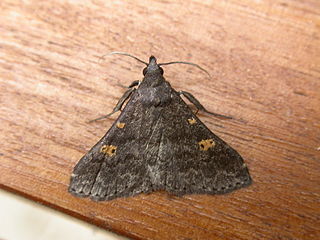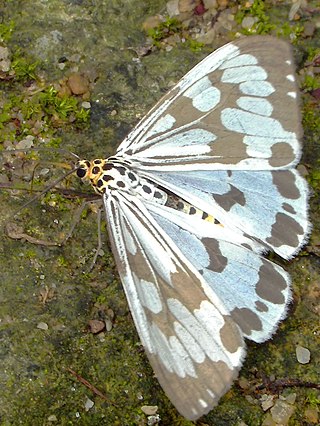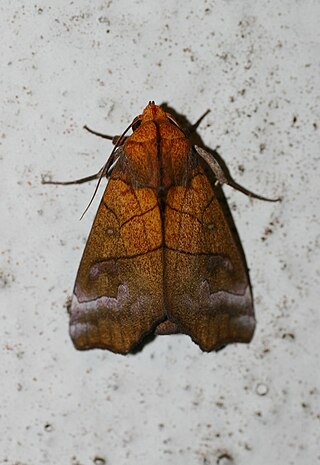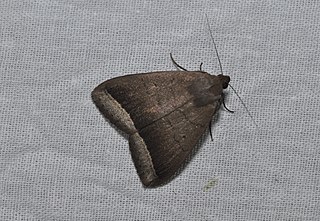
Brunia is a genus of tiger moths in the family Erebidae. The genus was erected by Frederic Moore in 1878.

Naarda is a large genus of erebid moths currently encompassing 108 species. Initially identified by Francis Walker in 1866, it is in the family Erebidae. Somewhat ruddy in appearance, this genus is distinguishable for its generally slender thorax and abdomen, and straight, porrect labial palpi. Most species are a light tan color, but shading can reach as deep as a charcoal, with muddy yellow, conspicuous reniform, orbicular stigmata featured on the forewings, sometimes reflected bilaterally superior.

Homodes is a genus of moths of the family Erebidae first described by Achille Guenée in 1852.
Hypenagonia is a genus of moths of the family Erebidae first described by George Hampson in 1893. The adult moths have pale brown wings with a dark band across each wing. The wingspan of these moths is about 1 centimeter.

Micromorphe is a genus of tussock moths in the family Erebidae. The genus was erected by Felder in 1874.

Trigonodes hyppasia, the triangles or semi-looper, is a moth in the family Erebidae. The species was first described by Pieter Cramer in 1779. It is largely cosmopolitan, found throughout Borneo, Fiji, India, Nepal, Sri Lanka, São Tomé and Príncipe, Taiwan, Thailand, Zimbabwe, northern Australia, and almost all African countries.

Nyctemera adversata, the marbled white moth, is a moth of the family Erebidae first described by Johann Gottlieb Schaller in 1788. It is found in Sri Lanka, Bangladesh, India, Nepal, Myanmar, China territories like Tibet, Sichuan, Yunnan, Guangdong, Hong Kong, Hainan, Guangxi, Hunan, Henan, Zhejiang, Jiangxi, Fujian, Taiwan, Japan, Peninsular Malaysia, Thailand, Indonesia Philippines.

Cyana malayensis is a moth of the family Erebidae. It is found in Peninsular Malaysia, Borneo and Palawan.

Anomis scitipennis is a noctuid moth of the family Erebidae. It is found in Peninsular Malaysia, Sumatra, Borneo, Thailand, Sulawesi and New Guinea. The species mostly inhabits lowland forest.

The Erebidae are a family of moths in the superfamily Noctuoidea. The family is among the largest families of moths by species count and contains a wide variety of well-known macromoth groups. The family includes the underwings (Catocala); litter moths (Herminiinae); tiger, lichen, and wasp moths (Arctiinae); tussock moths (Lymantriinae), including the arctic woolly bear moth ; piercing moths ; micronoctuoid moths (Micronoctuini); snout moths (Hypeninae); and zales, though many of these common names can also refer to moths outside the Erebidae. Some of the erebid moths are called owlets.

The Erebinae are a subfamily of moths in the family Erebidae erected by William Elford Leach in 1815. Erebine moths are found on all continents except Antarctica, but reach their greatest diversity in the tropics. While the exact number of species belonging to the Erebinae is not known, the subfamily is estimated to include around 10,000 species. Some well-known Erebinae include underwing moths (Catocala) and witch moths (Thermesiini). Many of the species in the subfamily have medium to large wingspans, up to nearly 30 cm in the white witch moth, which has the widest wingspan of all Lepidoptera. Erebine caterpillars feed on a broad range of plants; many species feed on grasses and legumes, and a few are pests of castor bean, sugarcane, rice, as well as pistachios and blackberries.

Lymantriini is a tribe of moths of the family Erebidae. This tribe is a group of polyphagous moths that reside mostly in the tropical regions of Afro-Eurasia but also North America.
The Pericymini are a tribe of moths in the family Erebidae.
The Catephiini are a tribe of moths in the family Erebidae.
Cyme euprepioides is a species of moth of the family Erebidae. It is found on Borneo, Sumatra, Peninsular Malaysia and in the north-eastern Himalayas and the Philippines. The habitat consists of various lowland forest types.
The Hulodini are a tribe of moths in the family Erebidae.

The Hypopyrini are a tribe of moths in the family Erebidae.

The Ommatophorini are a tribe of moths in the family Erebidae.

The Sypnini are a tribe of moths in the family Erebidae.

Simplicia bimarginata is a moth of the family Erebidae first described by Francis Walker in 1864. It is found in India, Sri Lanka, Malaysia, Indonesia, New Guinea, Singapore, Sumatra, Borneo, the Philippines and Sulawesi.














